 TOUT
CE QUE VOUS VOULIEZ SAVOIR SUR
TOUT
CE QUE VOUS VOULIEZ SAVOIR SUR
LA PILE A COMBUSTIBLE
FUEL CELLS: STATUS AND PERSPECTIVES
Café des Sciences, CERN/Genève, Cl. ROULET (Schlumberger)
Organisé par l'association Euroscience-Léman
16 novembre 2000
HISTORY
-
PRINCIPLE DISCOVERED BY WILLIAM OROVE (1839)
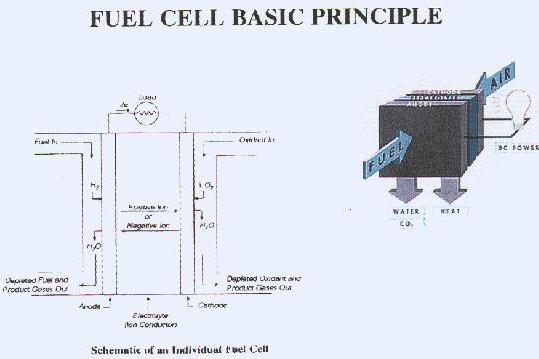 NASA Gemini program: GE (PEM technology: Proton Exchange Membrane), then
abandoned
NASA Apollo program: United Technologies Corporation, subsidiary IFC (AFC
technology: Alkaline Fuel Cell)
Greatly improved version to provide electrical power to the shuttle
NASA Gemini program: GE (PEM technology: Proton Exchange Membrane), then
abandoned
NASA Apollo program: United Technologies Corporation, subsidiary IFC (AFC
technology: Alkaline Fuel Cell)
Greatly improved version to provide electrical power to the shuttle
- Needs extremely pure H2 and O2
- Prohibitive costs for civil commercial applications
-
PEM Technology development resumed 1984 (Ballard Power Systems with Canadian
R&D money)
To-day main type of fuel cell being developed to power automobiles
Can operate with air and lower grade hydrogen, such as reformed methanol
Expensive catalyst (Pt), problem being solved now by thin layer of microscopic
Pt on electrodes
PAFC (Phosphoric Acid Fuel Cell) technology was aggressively developed
(US and Japanese companies)
First type to be commercialized
185 units have been commercialized to date for stationary power generation
(UTC- ONSI) 200-250kW
May operate on impure hydrogen and air
Power output lower than PEM technology
Does not respond well to changing power demand
US government still put tens of M$ into PAFC
TYPES OF FUEL CELLS
Electrolyte: KOH, operation 120 10 250o C
CO, CO2: poisons, wide range of electrocatalysts
Efficiency Up 1070%
Long used by NASA
Prohibitive cost for commercial applications
-
PAFC: PHOSPHORIC ACID FUEL CELL
Electrolyte: concentrated phosphoric acid, 150 to 220o C
CO poison of Pt electrocatalyst in anode
Easy water management
Efficiency 40%, 85% with cogeneration
The most commercially developed type of fuel cell:
- Diverse applicatons: hospitals,
hotels, office buildings, schools, utility power plants, airport terminals
- Can also be used in large
vehicles (buses & locomotives)
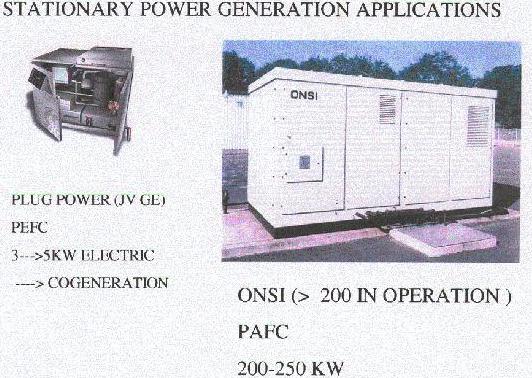
-
PEFC: POLYMER ELECROLYTE FUEL CELL
Electrolyte: ion exchange polymer membrane, excellent proton conductor,
about 80oC
CO poison at low temperature
High catalyst load (Pt) at both electrodes
Only liquid is water, minimum corrosion problems
Critical water management in membrane for maximum efficiency
Efficiency: about 40%
High power density, flexibility to power demand, quick start
- Primary candidates for
light-duty vehicles, buildings, and much smaller applications such as video
cameras
-
DMFC: DIRECT METHANOL FUEL CELL
Similar to PEFC but anode catalyst draws H from liquid methanol, eliminating
need for reformer
Efficiency Up to 40% expected
Early stage of development
-
MCFC: MOLTEN CARBONATE FUEL CELL
Electrolyte: combination of Na & K carbonates retained in ceramic matrices
(LiAlO2)
Operation 600 to 700o C
Ni anode, Ni oxide cathode, inexpensive catalysts
High efficiency
Excess heat can be captured and utilzed in cogeneration
Large variety of fuels: natural gas, propane, diesel
- Suitable for ships, remote
places, stationary decentralized power plants

-
SOFC: SOLID OXIDE FUEL CELL
Electrolyte: solid, non-porous metal oxide, usually Y2O3
-
stabilized ZrO2
Operation 650 to 1000o C
Anode: Co-ZrO2 or Ni-ZrO2, cathode Sr-doped LaMnO3
Cheap catalyst
- Efficiency Up to 60%,
higher with cogeneration
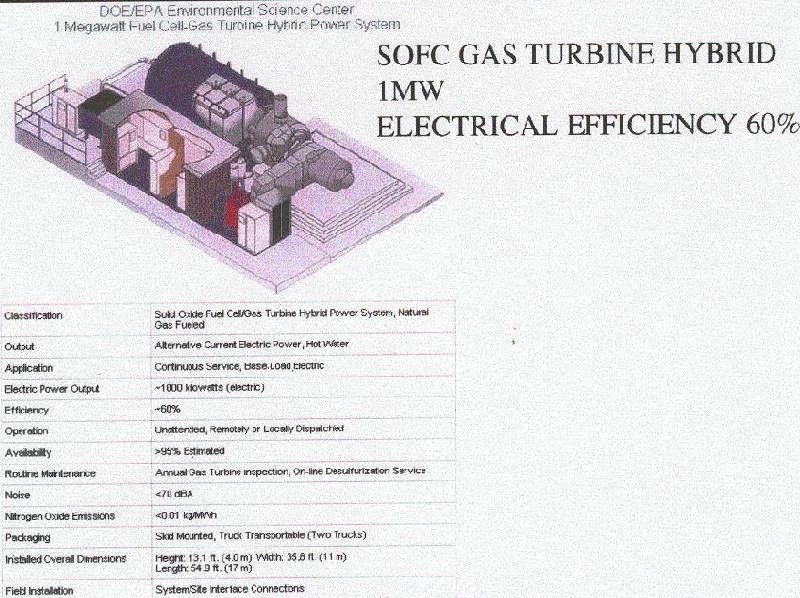
-
RFC: REGENERATIVE FUEL CELL
Very young member of the fuel cell family
Closed loop form of power management:
- Hydrogen and oxygen are
separated from water using a solar-powered electrolyser
- H2 and O2
are fed in fuel cell to produce electricity , water and heat
- Water is recirculated
back to the solar-powered electrolyser
Research conducted by NASA and other front end research centers
MOBILITY APPLICATIONS
TRANSIT BUSES:
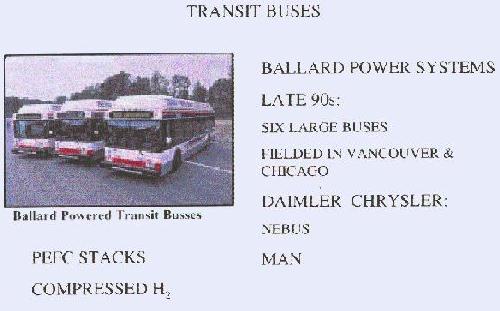
AUTOMOBILES:

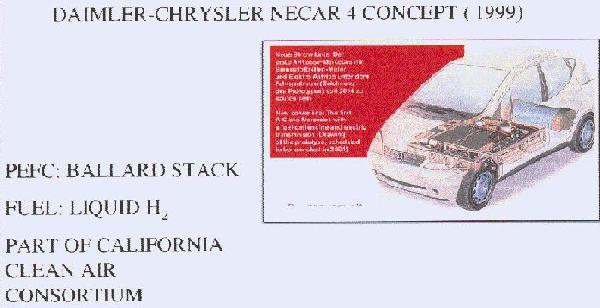
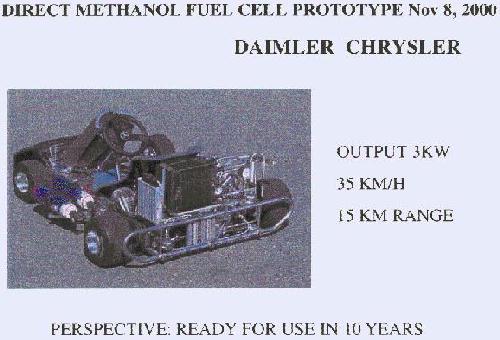
LOCOMOTIVES
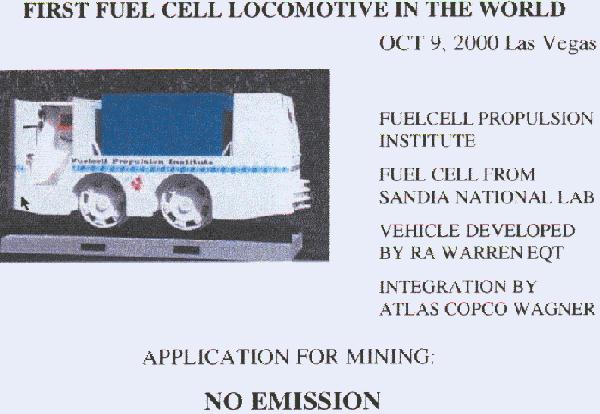
BICYCLES
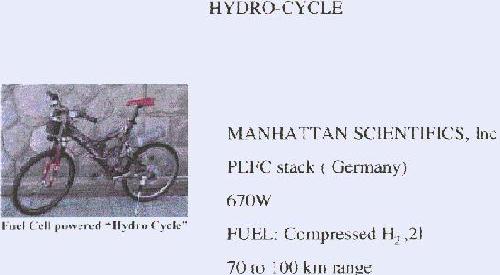
MAIN COMPANIES
CLEAR LEADER:
- BALLARD & its allies:
DAIMLER-CHRYSLER-FORD
JVs: DBB Fuel cell engines, ECOSTAR Electric Drive Systems
CALIFORNIA CONNECTION:
- Regulation of the California
Air resource Board (CARB):
2003: 4 % of new cars to be ZEV (ZERO EMISSION VEHICLE): 22000 ZEV/YR
- California Fuel cell project:
launched April 1999:
State of California, Daimler-Chrysler, Ford, Ballard, Arco, Texaco, Shell
- New Comers: GM, Toyota,
IFC-Methanex
- 20 FC cars and buses to
be fielded 2000 >> 2003
-
STATIONARY POWER GENERATION
- COMMUNITIES:
- LEADER: IFC
PAFC 200-250 kW
200 UNITS OPERATING
4K$/kW to day to be compared to Gas turbines: 500$ to 1000$/kW
- FECL:
MCFC 250kW
Collaboration with Daimler-Chrysler: MTU
- BALLARD:
PEFC 250 kW to be fielded
- SIEMENS:
SOFC 200kW
- DOMESTIC:
- LEADER: PLUG POWER 5kW PEFC with COGENERATION
- BALLARD
- H-POWER
FUEL ISSUES
-
IDEAL FUEL: PURE H2, BUT…:
- NEW
AND HEAVY INFRASTRUCTURE FOR TRANSPORT
- COMPRESSED H2 TOO BULKY FOR CARS, MAY BE ACCEPTABLE FOR LARGE
TRANSIT BUSES
- LIQUID H2: COMPACT STORAGE BUT COST 30% OF ENERGY
- HYDRIDE STORAGE: VERY PROMISING: from 7 % in weight (ECD) to 11% (LANL)
- PRIME
CANDIDATE:METHANOL
ABUNDANT
CAN BE OBTAINED FROM NATURAL GAS, BIOGAS
- GASOLINE:
PRESENT DEVELOPMENT BY NUVERA, PLUG POWER, IFC-TOYOTA, DAIMLER-CHRYSLER-SHELL…)
- SOURCES:
- VIA REFORMING:
FOSSIL FUELS OIL & GAS
METHANE (CMM,CBM)
STRANDED GAS
HYDRATES
BIOMASS, ORGANIC WASTE
- CO2 SEQUESTRATION POSSIBLE IF CENTRAL REFORMING
-
VIA HIGH PRESSURE ELECTROLYSIS OF WATER
- ELECTRICITY FROM CENTRAL POWER PLANTS
- ELECTRICITY FROM DISTRIBUTED RENEWABLE ENERGY STATIONS:
SOLAR
WINDTURBINES
GEOTHERMAL (EX: ICELANI) TOTAL H2 PROJECT)










